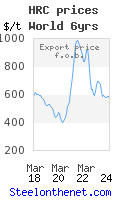Market, environmental appeal raise questions for coke plantEBENSBURG, PA - Plans for a high-tech coal-to-coke plant near Ebensburg are on the fence because of an environmental appeal and a fluctuating international market.
But state officials remain confident that the massive project, expected to create 750 jobs, is still a "go."
The state's highest-ranking environmental official expressed concerns during a Tribune-Democrat interview Thursday that a drop in coke prices is causing project backers to re-evaluate their plans.
Kathleen McGinty, secretary of the state Department of Environmental Protection, said Gov. Ed Rendell is personally involved in trying to ensure the coke plant does come to Cambria County. "The governor has been very strongly encouraging and calling the president of Mittal Steel to try to secure from him a commitment," she said.
However, state officials have been informed of Mittal's "intention to review all of the proposed investments that were under way under ISG's ownership," McGinty said.
Industry insiders say softening coke prices are not the main factor because that market typically fluctuates.
Instead, they say, the recent environmental challenge to DEP's permit for the coke plant is chilling Mittal Steel's plans for the facility, to be operated by a division of Sunoco. If the challenge cannot be resolved, or if the cost is too high, Mittal most likely will build the coke plant in Poland, insiders predict.
Economic-development officials in the region are holding their breath and hoping the project is not in jeopardy. "Mittal is looking at the site plan, the cost of coke, where they can sell it to. And then when they get glitches in the permitting process, time and money become the huge issues," said Ron Repak, executive director of the Johnstown Redevelopment Authority. "Mittal is saying now that we don't have a permit, we have to go through this whole long, costly process again," he said.
"But the governor has stepped forth and made substantial offers of assistance to the project. He's written to Mittal, and maybe even made calls," Repak said, echoing McGinty's assessment.
"He wants this project in Cambria County," he said.
When plans for the coke plant were announced early this year, there were three players:
- Amfire Coal Mining Co. in Latrobe, which will mine coal in Cresson Township.
- SunCoke Co., a division of Sunoco, which will build and operate a new 280-oven coke plant at Mine 33 south of Ebensburg.
- International Steel Group of Cleveland, which purchased Bethlehem Steel Corp.'s reserves, and was in the process of merging with Mittal Steel, an international conglomerate with operations in 14 countries on four continents.
Since then, two things have happened. PennFutures, a well-financed environmental activist group based in Harrisburg, has filed a legal challenge to the DEP permit, asking for stricter emissions controls and other modifications. And the merger of ISG and Mittal has been consummated, and Mittal is reviewing and evaluating its new assets and commitments.
Mittal and SunCoke officials declined to comment on the status of the project, or the appeal, saying they cannot discuss any matters under litigation.
Those close to the negotiations say Mittal might be holding back on a commitment to Rendell as an attempt to drive up the state's subsidy for the project, and to take a strong stance in the face of PennFuture's legal challenge.
Coke prices are the least important factor, because the plant would be a long-term financial commitment on the part of Mittal, SunCoke and Amfire, they said.
Until the appeal is settled, Mittal is not going to make a decision and, with the appeal pending, the plant cannot be built, company officials have said.
"This gives Mittal time to investigate their options and see what they want to do," said an industry expert who spoke on condition of anonymity because of the pending litigation.
"They are a worldwide steel company, with lots of options."
In addition to getting more time, some say Mittal could use the delay as a tactic in receiving financial incentives above the $3 million first committed by the Rendell administration to ISG.
Also, the recently passed federal energy bill will give a tax break to facilities such as the coke plant, they say.
If it is built, the massive facility would be capable of producing in excess of 1.5 million tons of coke per year, which would be sold to Mattel.
Steam generated as a byproduct would be converted to electricity at a 125-megawatt power plant, also to be built near Mine 33. Construction would take two years, SunCoke officials have said.



